•
18-minute read


Producing great content is one of the best strategies to get traffic. Except it takes quite a while for your content to be discovered organically. It could be months, years, or perhaps even never. Which is why you can't afford to wait for the audience to come to you — you have to go to where your readers are and invite them in.
The challenge, of course, is that the Internet of today has grown tired of generic content promotion attempts and you can't just run around dropping links. No, today you have to find a custom approach to each individual community you want to borrow traffic from. You have to invest time, make valuable contributions, and become an actual member.
Or you can buy ads and skip all the work, but I'm going to go ahead and assume that very few of us here have the budget to buy our way to the top of the market. So, for now, let's focus on these:
Back in the day, the audiences used to belong to websites, but now it's more about individual opinion leaders within those websites. Whether it's due to the perception of higher accountability or to a sense of personal connection, influencers of today command as much if not more attention than brands and media outlets.
Having your content endorsed by an opinion leader in your field will give you the greatest traffic boost outside of a paid promotion campaign. The obvious challenge here is how do you find opinion leaders and motivate them to mention your content to their audiences:
Opinion leaders tend to command narrow audiences, so the first thing to do is to break your audience down into smaller segments, where it is easier to identify who the influencers are. If, for example, you are selling technical winter jackets, then you can split your audience into athletes, wilderness enthusiasts, hunters, and casual wearers. And then go a level deeper and split athletes into climbers, skiers, and snowboarders, and then split wilderness enthusiasts into campers, hikers, and trekkers, and so on.
Once you've got a list of segments, you can poke around social networks and seek out segment influencers based on hashtags, locations, and other search options. Or you can save a ton of time by employing social listening software. Using Awario as an example, all you'd have to do is choose keywords (brands, topics) to track and you'll get a full list of popular accounts using those keywords most often:

The easiest and the most realistic strategy for a novice content creator is to mention in your content something an opinion leader had said or done in the past. It could be anything, a tweet, an article, a video, or a product — prominently featured, properly credited, and linked to the original source.
And once the piece of content is published, write to the featured opinion leader and say you've mentioned them and here is the link and perhaps they'd feel like sharing it with their audiences. It's totally fine if they don't, no need to be pushy, just try your luck next time. The key here is to act natural and find a way to provide value to the influencer and to their audience.
A more advanced strategy is to reach out to an opinion leader before you publish your content, ask them to comment on an issue that they are known to be passionate about, and then feature their comment within your content. Below is a screenshot from an article where we did just that:

In an attempt to drive more value for the participating opinion leaders, we had featured each comment prominently, with a photo, a bio, and a link, and we were lucky enough to have everyone involved in the article mention it to their audiences:

Keep in mind that expert roundups have been done to death and a generic approach is not likely to be successful with readers. So, instead of emailing a ton of influencers the same question, pick those people that are likely to have differing opinions and unique experiences and then approach each of them individually.
Reddit is the third most visited website in the US, with about 1.5 billion monthly visits and an incredibly engaged community. All content on Reddit is user-generated and a lot of that content features links. So, on the surface, it sounds like Reddit is a content promotion goldmine.
It's not. The community thrives precisely because it's authentic and because its users are extremely vigilant towards self-promotion attempts. Redditors are a very tough crowd to sell to. But not impossible. All you have to do to survive and perhaps even succeed on Reddit is become a Redditor yourself:
Karma points are earned by making posts and comments that are upvoted by other Redditors. Do not attempt promotional posts until you've got enough karma to show that you are a legit community member.

Aim for at least 50 karma points before your first self-promotion post, but the more the better. Earning that initial karma is also a good opportunity to learn the ropes and see what kind of content makes it on Reddit.
Each subreddit is its own community with its own interests, content formats, and moderation policies. Your goal is to establish yourself in those subreddits that are active, relevant to your business, and not terribly strict on self-promotion.

Keep in mind that your endgame is not just traffic, but traffic that converts. So you have to seek out those subreddits that contain your potential buyers. For example, if you were to write a blog post about the top ten most fashionable winter boots, you'd probably have no problem getting some traffic from a copywriting subreddit and asking for some writing pointers. But the visitors you'd get from this subreddit are not your buyers, they are not interested in boots, fashion, and winter gear, which are the subreddits you should have aimed for instead.
Big brands and big names can have incredible success by hosting Reddit AMA (Ask Me Anything) sessions. But it only works if you are famous or if you have a very unique life experience, which not many people do. And even then, AMAs are not as much about content promotion as they are about reputation building.
For a smaller brand, a popular strategy to engage users is to ask for feedback on anything, from products to website design to business strategies. Again, if you were to make a listicle of most fashionable winter boots, you could go ask a corresponding community whether they agree with the list and what their lists would look like.
Another strategy is to use your content for comments on other posts, where posters ask for information or advice. The best way to do it is to provide an answer, mention that you know about the topic because you've researched it for one of your recent articles, and then hope for someone else to ask you for the link. This way you don't have to push your content in an unsolicited manner.
On Reddit, there is no shortage of users who will go through your entire post history and see whether you are trying to take advantage of the community. In fact, there are entire subreddits dedicated to just that. So, when you finally decide to attempt promotional posts, keep their share to about one in ten, with the rest being genuine contributions unrelated to your business interests.
Reddit is no place to be coy about your relationship with the business you are trying to promote. No fake accounts (shills), no spamming, no misleading anchors, none of that stuff is likely to work even once. Whenever you make a self-promotional post, include full disclosure about who you are and create proper expectations of what the content is and why is it valuable/relevant to this particular subreddit. Make sure to familiarize yourself with Reddit's content, spam, and self-promotion policies.
Quora has over 300 million monthly active users, but its true advantage is that it's very SERP-friendly. Whenever you make a question-like inquiry, Google is very likely to serve you at least one Quora answer, as well as feature a few more Quora pages in its rich answer snippet. So, if you make your content visible on Quora, it is also likely to get some organic exposure via Google search results.

Above is me asking Google about the importance of SEO audit and the answer from Quora is not only ranked third, but also features a few more similar threads from the platform. Impressive SERP real-estate by anyone's measure and it's yours for the taking.
Another advantage of Quora is that the community is not as nuanced and as hardcore as it is on Reddit. And there are no strict guidelines on what types of content are allowed. You can do text, images, video, and links, including self-serving links — whatever is necessary to answer the question in full.

Above is one of my content promotion posts on Quora. It includes a link to my recent article about E-A-T, but only after I've given a sufficient answer on the platform. In general, this is the way to go, but there are a few more things to consider for your Quora strategy:
Quorans tend to ask the same questions over and over again. There are usually a dozen variations of the same question on the platform, and you never know which one of those variations is going to get traction with the community:

To maximize your chances of success, you have to use your content to answer as many questions as possible. Start by googling your keywords and finding those Quora pages that come up in search — those are your top priority. Beyond that, check related questions at the bottom of each question page and search for your topics using Quora search bar.

Once you've answered a dozen or so questions on any given topic, Quora will ask you to answer other questions on this topic. After a while, you will become recognized as an expert on your topics and Quora users will start sending you direct requests to answer newly added questions — that's a great opportunity to provide one of the first answers and get a head start on collecting views.
Perhaps the biggest challenge of Quora is that each of your answers has to be written from scratch — copy/paste answers are at a very high risk of being removed. Don't worry, it goes fairly quickly — you have just written the article and will have no problem paraphrasing the key idea a few more times. Also, remember that each Quora question gets from a few to a few hundred answers, so your copy has to be competitive enough to get noticed.
While you have to spread your content across as many similar questions as possible, you can't do it too quickly and you can't post duplicates, or you'll get all of that work removed by the moderators:

Above is what happened to me when I went a little too fast and answered a few very similar questions within minutes of each other. Not only were my answers removed, but I had also been permanently banned from writing new answers to those questions, which is probably costing me some good traffic. So my advice is to stick to one or two original, quality answers per day.
You can get your answers rank above other answers by building credibility with the platform and its users. Your answers will be given more and more priority as your total count of views, upvotes, and shares goes up. Mine is a tad above half a million, and I often see my answers go straight to the top of the pile simply because of the authority associated with my personal account.
Deliver your content to a potentially willing audience by employing social listening to find and hijack the conversations around your subjects. One way to do it is to go on social networks and use a search bar to look up subject keywords, but the results are likely to be few as most networks offer very limited search capabilities.
Another way is to use social listening software to augment the scope and the relevance of your conversation search. Awario offers a dedicated lead-generation tool that allows you to select social networks to search, as well as locations, languages, timeframes, and some semantic nuances of the conversations you want to target.

It goes without saying that you should take good care of each lead discovered this way, after all, you are intruding on a relatively private space. Don't just post a link to a piece of content and leave — engage the users and create some context for the link you are about to share.
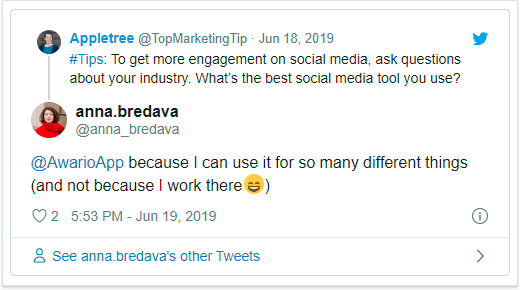
Above is our pals from Awario using social listening to find conversations around their industry and plug their product, and below is us doing the same to share a few pieces of content:

Throwing your article onto a content sharing platform is not going to drive much traffic to your website, but it also requires the least amount of effort, so why not do it anyway.

Each of our own articles goes on tech platforms, like GrowthHackers and Zest, but you might be able to find similar platforms for other industries. One way to look for those platforms is to use SEO SpyGlass and discover websites that link to some of your competitors, but not you. Below is an example of me using SEO SpyGlass to find intersecting links for two of the most popular outdoor retailers:
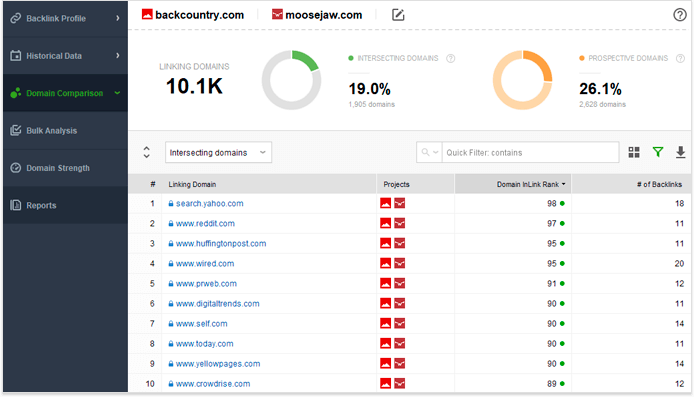
Another low effort way to deliver your content to a wider audience is to repost your articles on Medium. It is a self-publishing platform with over 100 million monthly readers and over 200,000 paying subscribers. Medium is free for bloggers and mostly free for readers, except for the most popular content, which is hand-picked by Medium staff and hidden behind the paywall.
Simply copy all of your article and paste it into the Medium editor. Most of the time, Medium would keep the original formatting, headers, links, quotes, and images, so there is barely anything you have to fix before publishing. The editor does have some advanced features that might help you spice the article up, so make sure to check those out as well.

Above is a screenshot from one of my articles reshared on Medium. The only editing I make is I add a brief disclaimer at the end of each article to drive the traffic and potential blog subscribers back to our website.
If your goals are different from driving blog subscribers, then you will have to edit your Medium posts for the actions you are interested in. You may want to link directly to product pages, or to other articles further down your marketing funnel.
There is very little you can do to influence the way your content is distributed on Medium. If you are a new contributor with no following of your own, then the platform will show your post to a few readers and, if those readers show interest, you might get further exposure and perhaps even get into the featured feed and daily digest email. If nothing happens to your post within the first couple of hours, then it might help to delete it and post again at a different time.
About the only thing that can increase your traffic dramatically is submitting your post to a publication. Publications are content feeds with their own subscriber base, which can contain hundreds of thousands of readers. The feeds are usually organized around a certain theme and curated by other users, groups of users, brands, or anyone really.

Some of those publications accept content submissions, but you have to match their content guidelines to be considered. And the guidelines can get quite extreme. The Writing Cooperative, for example, only considers unpublished drafts, forbids the use of drop caps, and requires all images to be properly described and credited, among about a hundred other requirements.
The most valuable asset behind a piece of content is the research that went into making it. The resulting piece of content is just one shape that this research can take. With relatively little effort, this research can also be converted to any number of other content types.
An article can easily become a presentation, a presentation can become an infographic, an infographic can become a video, and a video can become a podcast. And with each of those comes a new distribution channel and a new audience that has a preference for this particular type of content.

Presentations can be shared for free on Slidesgo, where there is quite a demand for the decks around marketing and overall business themes. Podcasts can be shared on a dozen dedicated platforms, like Buzzsprout, Captivate, Transistor, and Simplecast, to name just a few. You can also have a live podcasting session with your guests and then submit a recorded version on those platforms to get more exposure. Infographics can get some traction on Pinterest, but can also be used internally as gated content. Videos would go on YouTube, obviously.
There are two ways you can use your content to harvest SEO guest posting traffic. One is to pitch an article idea similar to your existing content and then basically rewrite your content to match the requirements of your guest posting partner. Another way is to create a thematically similar guest post and then link to a number of your own related posts from within the text. You can take more inspiration by employing an AI text generator to craft engaging and unique content that aligns seamlessly with your thematic guest posts and elevates your SEO guest posting strategy.
Remember that in both cases you have to drive value for your partner as well as yourself. There is a finite number of worthy guest posting opportunities in any industry, meaning there's likely to be no more than a handful of blogs that can bring your real exposure. So your primary goal is to build and nurture the relationship with your partners. The value for them is that they get to fill out their content schedule and insert a few of their own links without having to do much work. The value for you is that you get to access their audience.
You probably already know who are the most popular content publishers in your industry, but you can always use SEO SpyGlass to expand your list of potential partners. All you have to do is enter your competitor's domain name and see their complete backlink profile. Filter and sort the results to find authoritative websites with lots of links, and a fair share of them are likely to belong to bloggers, experts, and industry publications.

Motivate your readers to spread the content via their own social network accounts.
The most passive way to encourage social sharing is to offer social sharing buttons, which you probably already do as those buttons tend to be provided by default in most website builder themes.

The plugin, of which there are many variations, allows you to place tweet suggestions throughout your article. Pick your best quotes, put them in the dedicated boxes, and prompt your users to tweet those quotes with a click of a button.
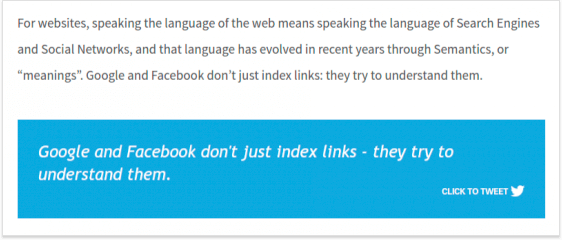
Another popular plugin type encourages users to share your article in order to access gated content. Here, the best practice is to offer users free access to your articles, but hide additional materials, like checklists, infographics, spreadsheets, and templates behind the ‘gate', which can be opened by sharing the article on social media.

While Facebook is a huge community of engaged users, it is almost impossible for a brand to get discovered there organically. About the only way to hijack someone's Facebook feed is to join a group that they are a member of and share your content there. There is any number of Facebook groups on any given topic, so, whatever your business, you'll definitely be able to find a few communities with corresponding interests.
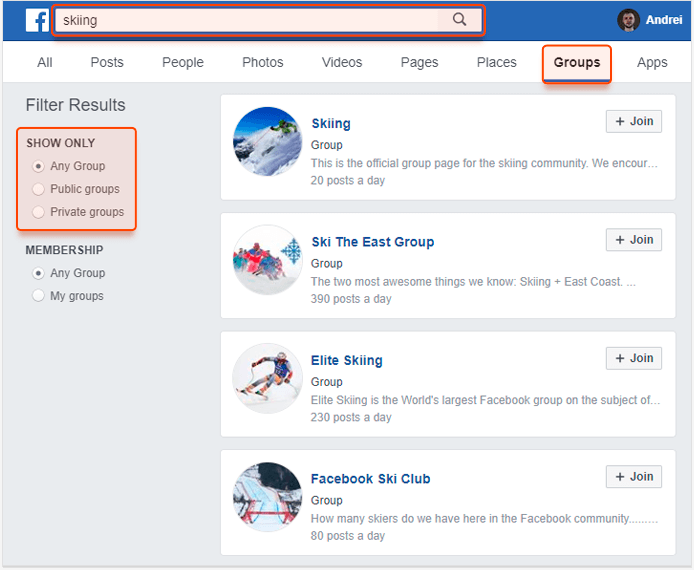
Note that there are private and public access options. Public groups are easier to join, which is actually a downside because they become quickly overrun with spam. With private groups, you have to apply to join and there is usually some kind of a screening process involved, so the quality of the audience tends to be higher than that of a public group.
The strategy is to join as many relevant private groups as possible, get a feel of the community and culture inside, and see whether and what kind of promotional posts are acceptable. Below is an example of Luke Rees, a writer at AWE365, using one of the private skiing groups to promote his recent article:
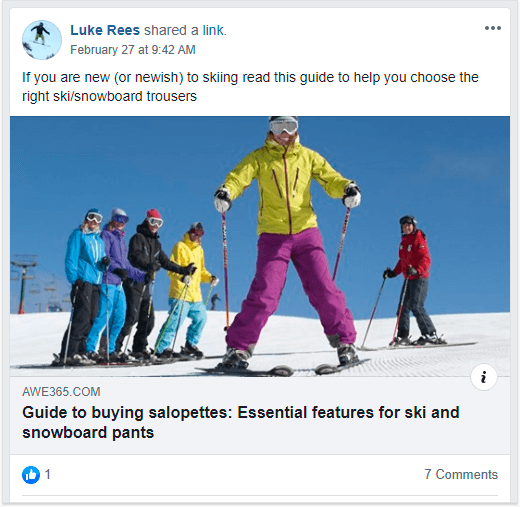
Sharing content via your own social media could also be a viable strategy for reaching new audiences. While you will be sharing with your existing followers first, they might be inclined to push your content to their own followers as well. There is usually a slight margin of new readers every time you share content with your followers — nothing to brag about, but it adds up.
With our posts, we've noticed that some people would share them without even reading the articles that the posts link to. Presumably, because they are not currently interested in the subject, but they believe that their followers might be. Fine by us.
Free does not mean easy. One running theme of free content promotion methods is that you have to invest your time instead of investing your money. Instead of paying to have your content delivered to willing users, you have to seek out those users yourself, hijack their conversations, and do your best to deliver your content in an authentic manner. That's on top of having to rewrite and repurpose your content to try and squeeze every last ounce of value out of every single piece you produce. It's a grind. But, done consistently, a perfectly feasible way to build an audience.

By: Andrei Prakharevich